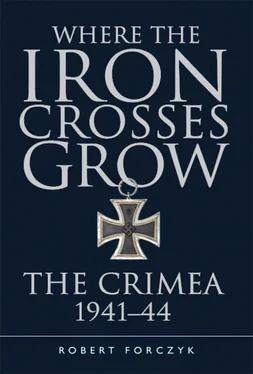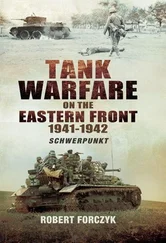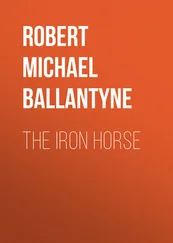Romanian 10th Infantry Division
Romanian 19th Infantry Division
111. Infanterie-Division (Generalmajor Erich Grüner)
V Armeekorps (General der Infanterie Karl Allmendinger)
73. Infanterie-Division
98. Infanterie-Division (Generalleutnant Alfred Reinhardt)
Gebirgs-Jäger-Regiment Krim (Major Walter Kopp)
Romanian 3rd Mountain Division
Romanian 6th Cavalry Division
Romanian Mountain Corps (Lieutenant-General Hugo Schwab)
Romanian 1st and 2nd Mountain Divisions
Romanian 9th Cavalry Division
9. Flak-Division
SOVIETS
4th Ukrainian Front (General Fyodor I. Tolbukhin)
2nd Guards Army (General-Lieutenant Georgy F. Zakharov)
• 13th Guards Rifle Corps (General-Major Porfirii G. Chanchibadze)
— 3rd, 49th, and 87th Guards Rifle Divisions
— 1,452nd Self-Propelled Artillery Regiment
— 512th Tank Battalion (Flamethrower)
• 54th Rifle Corps
— 126th Rifle Division
• 55th Rifle Corps
— 387th Rifle Division
• 26th Artillery Division (General-Major Nikolai V. Gaponov)
51st Army (General-Lieutenant Iakov G. Kreizer)
• 1st Guards Rifle Corps (General-Lieutenant Ivan I. Missan)
— 33rd Guards Rifle Division
— 91st and 346th Rifle Divisions
— 32nd Guards Tank Brigade
• 10th Rifle Corps
— 216th, 257th, and 279th Rifle Divisions
63rd Rifle Corps (General-Major Peter K. Koshevoi)
— 263rd, 267th, and 417th Rifle Divisions
— 22nd Guards Tank Regiment
19th Tank Corps (General-Lieutenant Ivan D. Vasil’ev)
• 6th Guards Tank Brigade
• 79th, 101st, and 202nd Tank Brigades
8th Air Army
• 7th Ground Attack Aviation Corps (General-Major Vasiliy Filin)
Coastal Army (General Andrei Eremenko)
• 11th Guards Rifle Corps (General-Major Serafim E. Rozhdestvensky)
— 2nd and 32nd Guards Rifle Divisions
— 414th Rifle Division
— 83rd Naval Infantry Brigade
— 85th Tank Regiment
• 3rd Mountain Rifle Corps
— 128th Guards Mountain Rifle Division
— 242nd Mountain Rifle Division, 318th Rifle Division
— 63rd Tank Brigade
• 16th Rifle Corps (General-Major Konstantin I. Provalov)
— 339th and 383rd Rifle Divisions
— 255th Naval Infantry Brigade
— 244th Tank Regiment
• Army Reserves:
— 89th and 227th Rifle Divisions
— 257th Tank Regiment
VVS-ChF
• 4th Air Army

“The Bolsheviks will be driven off and never return!” proclaims a propaganda poster distributed by 11. Armee in the Crimea. This poster ties in with Manstein’s secret memorandum about annihilating the “Judaeo-Bolshevik” system and depicts the Wehrmacht acting as exterminators under the Nazi banner. (NARA)
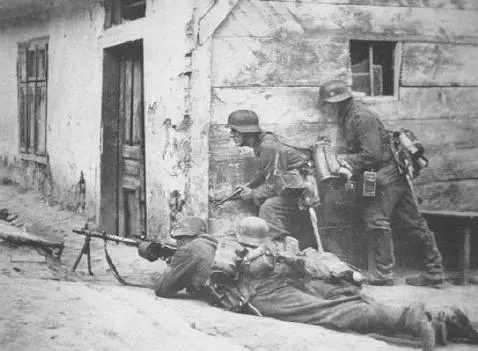
German infantry cautiously advance into a Crimean village, 1941–42. (Nik Cornish, WH 721)
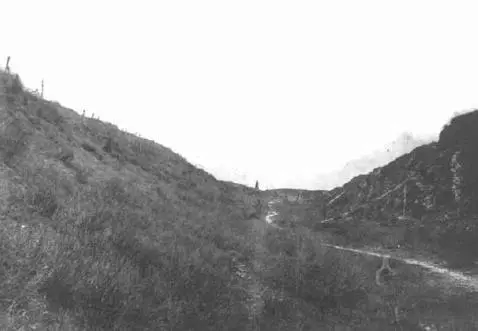
This photo was taken in 1920 from the bottom of the ditch below the Tartar Wall. At top left, the remains of barbed wire from the White trenches atop the wall are still visible. (Nik Cornish, RCW 111)
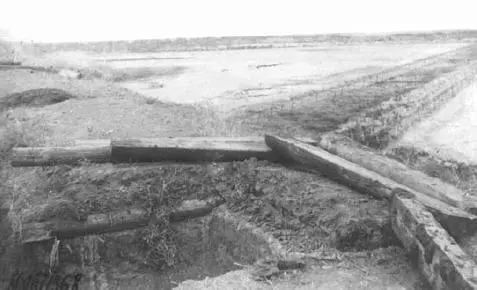
This is the point of Wrangel’s defenses on the Litovsky Peninsula along the Sivash where the Red Army took advantage of the weather to outflank the Perekop position by wading through the lower-than-usual water. Rows of barbed wire were established to bar the movement of small boats, but the fieldworks defending the obstacle were primitive and virtually unmanned. (Nik Cornish, RCW 94)
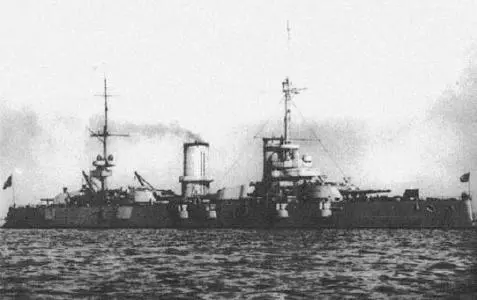
Since the time of Catherine the Great, Russian naval power in the Black Sea was based upon possession of the naval base at Sevastopol and the possession of capital ships to operate from that base. The battleship Parizhskaya Kommuna was transferred to the Black Sea in 1930 to serve as flagship for the fleet, but it subsequently proved to be ill-suited to operate in Crimean waters that were dominated by enemy air power. The Black Sea Fleet’s sole battleship and handful of cruisers did play a major role in stopping the initial German assault upon Sevastopol in November–December 1941, but afterwards sat out much of the rest of the war in obscure backwater anchorages. (Author’s collection)

Soviet coastal gunners at Coastal Battery 30 (later dubbed “Fort Maxim Gorky I” by the Germans) in Sevastopol before the German attack. The 305mm gun turrets were designed to traverse 360 degrees and could fire against naval or ground targets. Like the British at Gibraltar, the Russians at Sevastopol were more concerned about attack from the sea and put more effort into preparing for a naval attack that never came, rather than the landward attack that did. (Author’s collection)

Soviet VVS-ChF MiG-3 fighters of the 32nd Fighter Regiment based at the Chersonese airstrip south of Sevastopol in 1941–42. A small number of Soviet naval fighters tenaciously defended the skies over the naval base for six months until overwhelmed in June 1942. (Author’s collection)
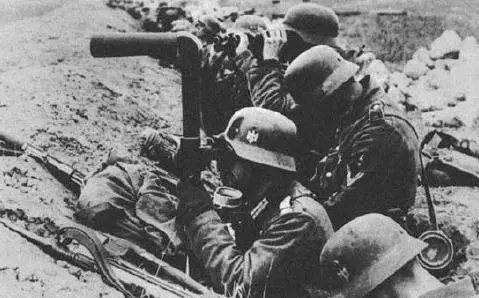
German soldiers from Hansen’s LIV Armeekorps observe Soviet positions on the Perekop Isthmus, September 1941. The 11. Armee was forced to mount a deliberate assault against a Soviet defense in depth, yet was not properly equipped with siege artillery or combat engineers. (Author’s collection)
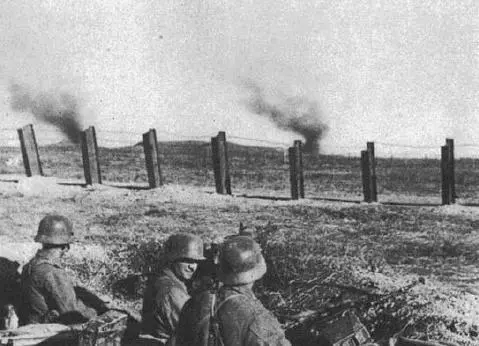
German infantry are seen here having occupied positions in the Soviet outer defenses at Perekop and are observing an artillery preparation of Fort Perekop. The Soviets planted steel beams in the ground to form an antitank barrier, and behind the barrier were numerous antipersonnel mines. (Author’s collection)
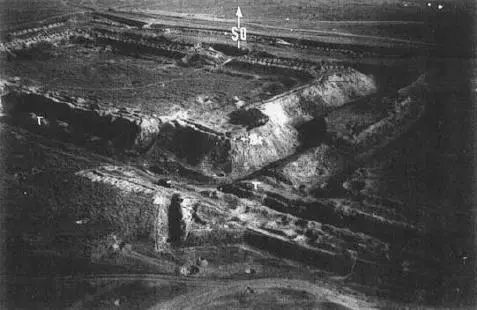
Fort Perekop, the main Soviet defensive position behind the Tartar Wall (the ditch is marked with a “T”). This obsolete field work, extant since the 17th century, was improved by Red Army engineers with protective trenches and a dense minefield on the approaches. Hansen’s troops never actually captured the fort, which was abandoned once the town of Armyansk (located to the south) fell into German hands. (NARA)
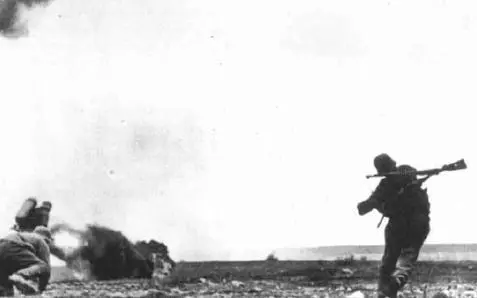
Hansen’s LIV Armeekorps used small Stossgruppen (assault groups) consisting of grenadiers and flamethrower-equipped pioneers to overcome the tough Soviet forward security positions at Perekop, before even reaching the Tartar Wall. Here, a grenadier flings a Stielgranaten at a Soviet position. Note that the entrenched Soviet defenders are virtually invisible, while the upright German attackers are fully exposed and vulnerable. (Author’s collection)
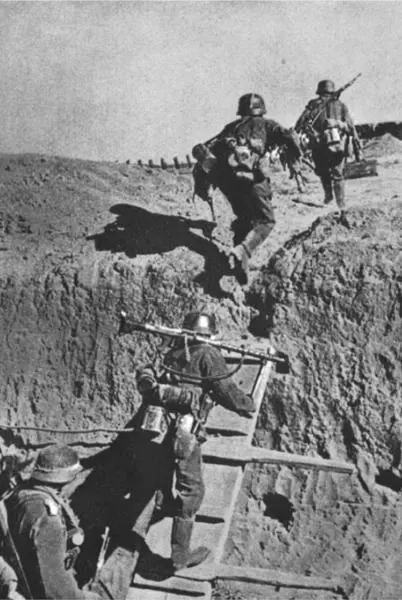
German infantry from the LIV Armeekorps crossing the Tatar Ditch on September 26, 1941. The steep walls formed an excellent defensive parapet and it was only through the use of aggressive combined-arms tactics that the Germans were able to breach this position so quickly. (Author’s collection)
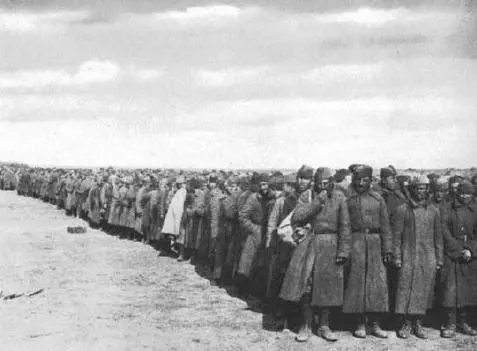
Soviet prisoners taken at Perekop, September 1941. The 51st Army failed to hold either the Perekop or Ishun defensive positions, and lost about half its troops and the bulk of its field artillery. (Author’s collection)

German infantry advance south from Ishun into the Crimea. Most of the 11. Armee could only advance at a walking pace. The flat, grassy terrain made movement easy but also rendered attackers very vulnerable to defensive fire when Soviet rearguards chose to stand and fight. (Author’s collection)
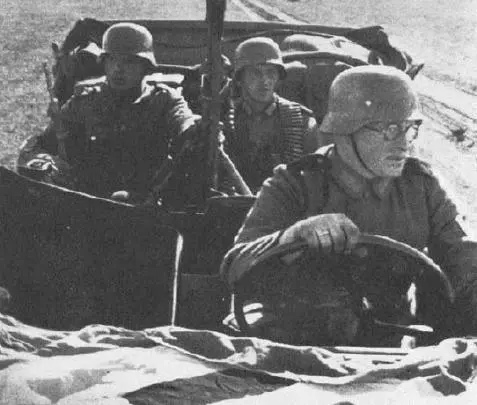
Once the Soviet defense at Ishun was broken on October 26, 1941, Manstein initiated a pursuit operation. Brigade Ziegler was an extemporized motorized unit, which consisted mostly of thin-skinned wheeled vehicles. Note the alertness of the German troops – looking out for Soviet rearguards or ambushes – and the air-recognition flag on the hood of the vehicle. (Author’s collection)
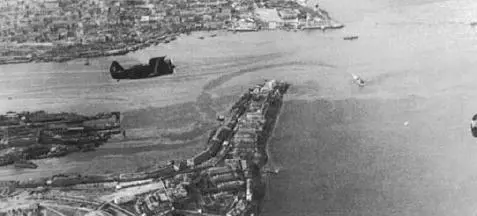
A Soviet I-153 “Chaika” fighter patrols over the entrance to Sevastopol’s Severnaya Bay in 1941. At this point, naval traffic in and out of the port appears still normal, with a minesweeper and transport in the background. However once the Luftwaffe appeared over Sevastopol, most naval traffic only moved at night, in order to avoid attacks. (Author’s collection)
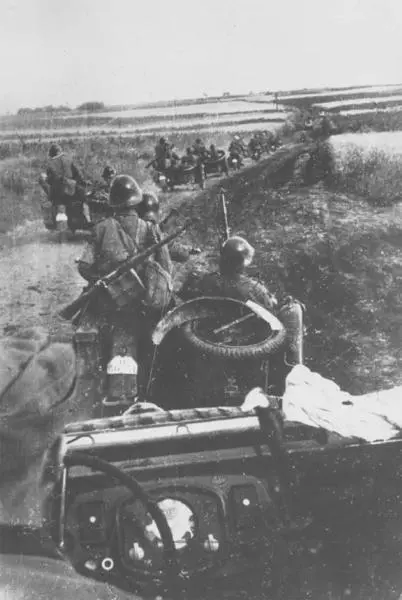
Romanian motorcycle troops from the 6th Motorized Rosiori Regiment were used in the pursuit after Ishun in November 1941, as well as during Operation Trappenjagd in May 1942. Note the German vehicle in the foreground, likely belonging to a liaison officer. (Nik Cornish, WH 1410)
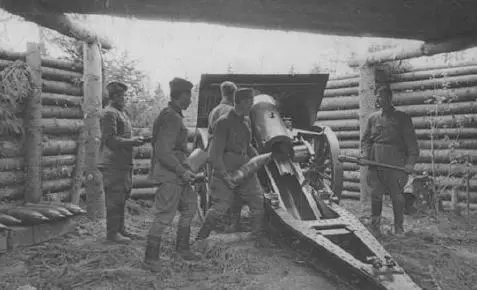
A Soviet 152mm howitzer in a wood-framed firing position. Most of Sevastopol’s perimeter defenses in late 1941 were still fairly basic in layout, and it was not until the winter that most of the artillery was emplaced in more robust positions. (Nik Cornish, RA 105)
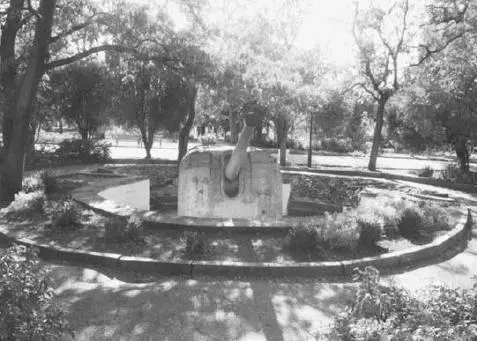
When the destroyer Sovershennyi was crippled by German bombers in Severnaya Bay, the Soviets stripped the wreck of its 130mm gun turrets and deployed them in two batteries on the Malakhov Hill. Matyukhin’s Battery 701 had two 130mm guns deployed in open concrete pits, which continued to operate until the final days of the siege. (Author’s collection)

A German infantry NCO cautiously peers around a shell-pocked building in a Crimean village. Note that he is prepared for unexpected close combat, with an entrenching tool in one hand. By the time that the 11. Armee reached the outskirts of Sevastopol in November 1941, its infantry units were severely depleted. (Author’s collection)
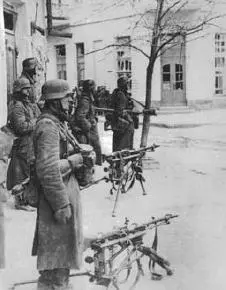
German troops from the 132. Infanterie-Division fought their way into Feodosiya on January 18, 1942, routing the Soviet 44th Army. Note that the weather is cold and that the German infantry are outfitted only with standard greatcoats. Manstein’s 11. Armee was greatly aided by the mild Crimean winter and suffered relatively few frostbite casualties, unlike the rest of the Wehrmacht on the Eastern Front. (Author’s collection)
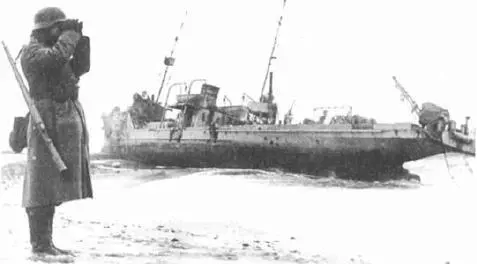
A German soldier at Yevpatoriya scans the sea for further Soviet landings, with the shattered wreck of the Tral-class coastal minesweeper Vzryvatel’ behind him. After running aground during the raid on the night of January 6, 1942, the Vzryvatel’ was riddled by point-blank fire from German 10.5cm howitzers. However, the defiant resistance of the doomed vessel served as an example of selfless service for the Black Sea Fleet and an indication to the Germans of the willingness of the Soviets to mount near-suicidal amphibious raids. (Author’s collection)

Caught by surprise by the Soviet capture of Feodosiya, Manstein was forced to abort his offensive against Sevastopol and hurriedly transfer elements of three divisions to retake the city. The 11. Armee did not possess much wheeled transport by January 1942, but unlike the rest of the Eastern Front, the Crimea did not receive sufficient snowfall to immobilize the German Army. (Süddeutsche Zeitung, 00403719)

After retreating from Kerch, the German 46. Infanterie-Division was forced to construct hasty defenses across the Parpach Narrows to prevent a Soviet breakout. The Soviet Crimean Front made four efforts to break through the Parpach Line between February and April 1942. Note the open nature of the terrain, which meant that troops were often under enemy observation. There were several stone quarries in the area, which the Germans used to gather material for their fighting positions. Due to a high water table, it was difficult to dig trenches in this area. (Süddeutsche Zeitung, 00403804)
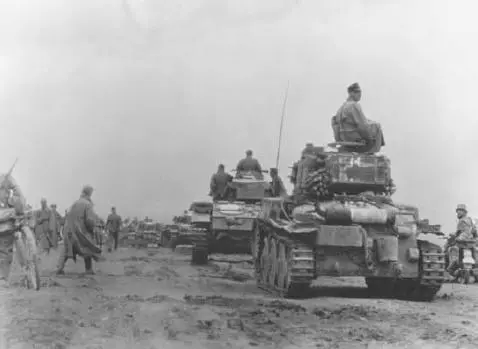
Manstein received the newly-raised 22. Panzer-Division in March 1942, but the unit was badly defeated in its first action on March 20, 1942. However, the division performed much better during Operation Trappenjagd in May 1942. This division was primarily equipped with the Czech-built Pz 38(t) tank, which could not stand up to the T-34 or KV-1 tanks encountered in the Crimea. (Süddeutsche Zeitung, 00403725)
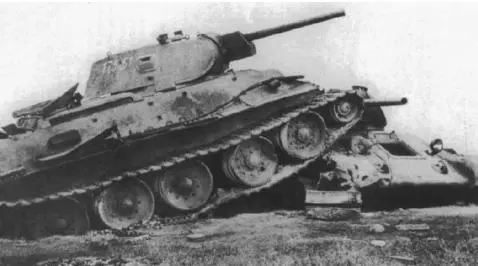
Two T-34 tanks lie wrecked near Koi-Assan on the Kerch Peninsula after the Soviet offensive in March 1942. The Soviets were unable to use their superiority in armor to break out from the Kerch Peninsula, and the Parpach Narrows became a lethal killing ground reminiscent of World War I battlefields. (Author’s collection)
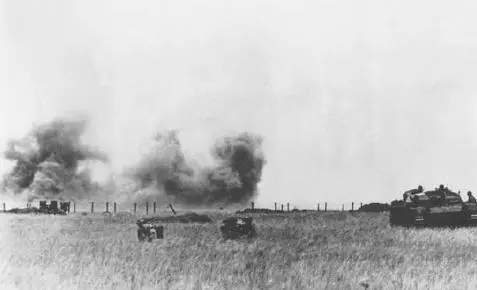
German pioneers and StuG III assault guns advance through the Soviet defenses at Parpach during Operation Trappenjagd in May 1942. Note the use of smoke to conceal the breach site in the Soviet obstacle belt. Manstein was able to overcome well-prepared Soviet defenses through the use of skillful combined-arms tactics and overwhelming air support. (Süddeutsche Zeitung, 00403782)
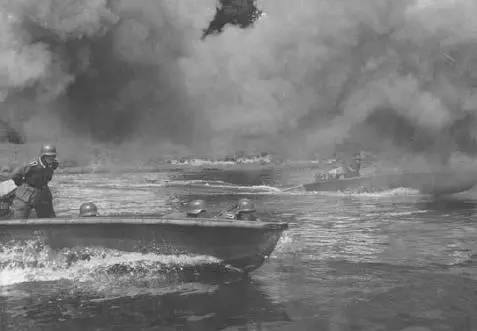
Manstein’s trump card in the Crimea was the assault boats of 902. Sturmboote-Kommando, which he used to outflank the Soviet defenses at Parpach in May 1942, and then to cross Severnaya Bay in June 1942. Using the element of surprise, these assault boats enabled the Germans to conduct a new form of maneuver warfare in coastal waters. (Nik Cornish, WH 1336)

The Svobodnyi, a Type 7U class destroyer, was the newest destroyer in the Black Sea Fleet, having been commissioned in January 1942. It was involved in the regular supply run from Novorossiysk and was caught in daylight hours by Ju-87 Stuka dive-bombers in Sevastopol’s Severnaya Bay on June 9, 1942. After being struck by multiple bombs, the destroyer sank near the Count’s Quay. (Author’s collection)
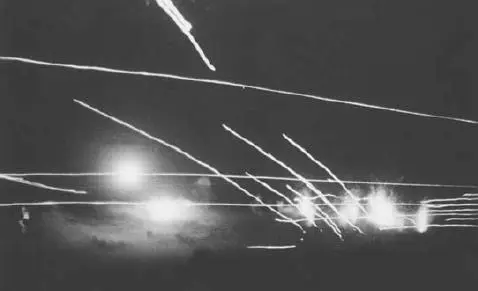
Tracers and parachute flares arch over the frontline trenches around Sevastopol in June 1942. Although most combat occurred during daylight hours, frontline units received regular harassing fire during the night, and the Soviet naval infantrymen were particularly fond of conducting local trench raids during hours of darkness. (Süddeutsche Zeitung, 00403699)
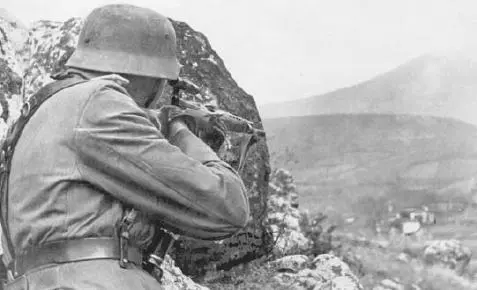
A German sniper looks for targets in the opposite hills around Sevastopol. Note that he is using a captured SVT-40 sniper rifle – which was highly prized by German soldiers. Positional warfare afforded ample opportunity for snipers on both sides to rack up a significant number of “kills.” (Süddeutsche Zeitung, 00059506)
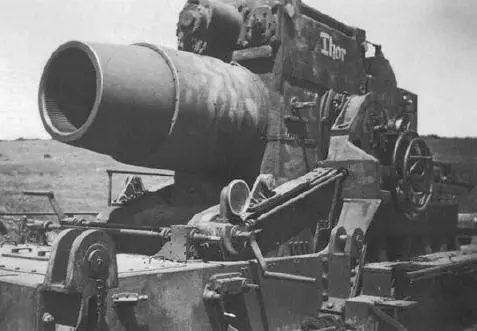
The “Thor,” one of two 60cm “Karl”-type super-heavy mortars deployed to reduce Soviet defenses at Sevastopol. The two mortars fired a total of just 122 rounds during the siege, and fired their last rounds on June 9, 1942, against Coastal Battery 30. While these 60cm mortars gathered a great deal of publicity, they were not really practical battlefield weapons due to their very short range. (Author’s collection)
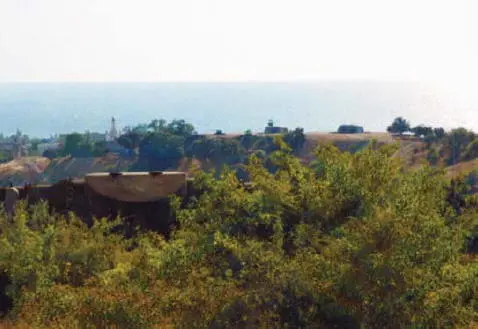
A modern view of the rebuilt Coastal Battery 30, with the rangefinder in the foreground and the two turrets in the background, facing the Black Sea. The Germans assaulted the battery from this angle and the photo gives a good indication of the constricting nature of the ridge. (Author’s collection)

A Luftwaffe ground crew prepares to load an SC 1000 bomb on a Ju-88 bomber. The Luftwaffe primarily relied upon 250kg and 500kg general-purpose bombs and did not have a large number of super-heavy or specialized bombs designed for attacking fortified targets. Consequently, the reduction of Soviet concrete gun batteries took multiple air attacks. (Nik Cornish, WH 1250)

The transport Abkhazia was sunk by German bombers in Severnaya Bay on June 9. The ammunition bunkers located behind the wreck of the Abkhazia in the chalk-faced cliffs are known as “White Cliff” – which was the target of the German 80cm Dora rail gun on June 6–7. Note that there is no evidence of a massive explosion as claimed by some German sources. (Author’s collection)
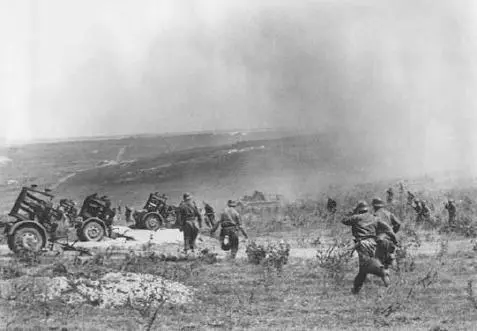
With all the attention given to “Dora” and “Karl,” it is often missed that the siege of Sevastopol represented the first opportunity for the Germans to employ massed Nebelwerfer rocket barrages in support of infantry attacks. Previously, they had been used only in small numbers, but at Sevastopol up to three or four battalions were simultaneously used to suppress a single enemy position. (Süddeutsche Zeitung, 00403714)
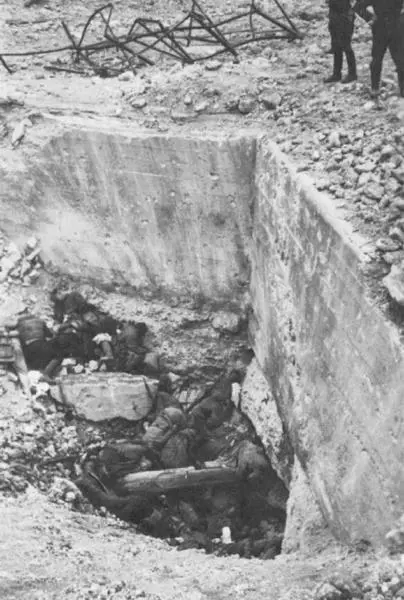
Dead Soviet troops inside one of Sevastopol’s concrete forts. The German air and artillery bombardments inflicted only modest casualties on the well dug-in Soviet troops, but served to suppress positions, which could then be overrun by German combined-arms assault groups. (Author’s collection)
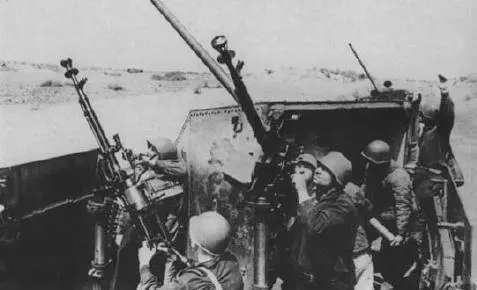
The Soviets employed three armored trains during the fighting in the Crimea in 1941–42. The Zhelezniakov was the most powerful, armed with five 100mm naval guns and numerous 12.7mm DShK heavy machine guns. These trains provided mobile firepower, but were extremely vulnerable to air attack. (Author’s collection)
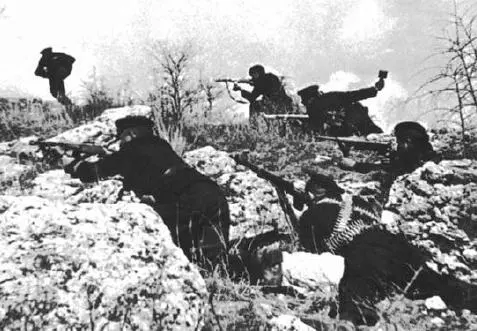
Soviet naval infantrymen counterattacking to regain lost ground. Note the mixed weapons: a PPSH-41 submachine gun, SVT-40 automatic rifle, and captured German MP-40. German troops were often unnerved by the sudden onslaught of Soviet naval infantrymen, who could emerge from terrain that was thought to have been cleared and then conduct near-suicidal close-quarter assaults.
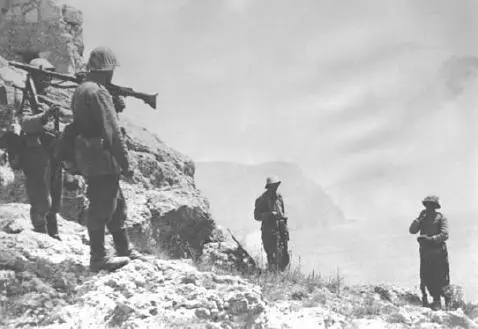
Romanian troops in the hilly terrain outside Sevastopol in June 1942. The performance of the Romanian Corps was decent, when properly supported by artillery and close air support. Without the participation of the Romanian mountain infantry, Manstein’s 11. Armee would have had a difficult time overwhelming Petrov’s Coastal Army. (Süddeutsche Zeitung, 00403679)
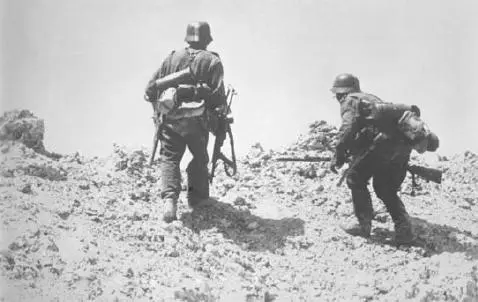
German infantry scramble up to the top of a shell-cratered hill outside Sevastopol, June 1942. Note that the German leader, armed with an MP-40, has a vertical white stripe painted on the back of his helmet. (Süddeutsche Zeitung, 00403689)

A German 10.5cm le. FH18 howitzer methodically shells Fort Constantine on June 24, 1942. By this point, German artillery clearly dominated Sevastopol’s harbor area and could strike targets almost anywhere in the city. Note that the German howitzer is deployed on a forward slope in broad daylight – apparently there was no fear of Soviet counterbattery or air attack by this point. The German artillerymen are acting as if they are on a range shoot. (Author’s collection)
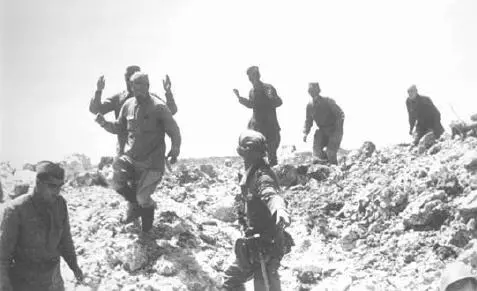
Soviet troops emerging from the ruins of shattered positions during the final fighting in late June 1942. The German 11. Armee captured 95,000 Soviet troops at Sevastopol, but very few officers above the rank of colonel. After bravely resisting for months against superior firepower, the soldiers of the Coastal Army were abandoned by their commanders, who slipped away in the dead of night. (Süddeutsche Zeitung, 00403653)
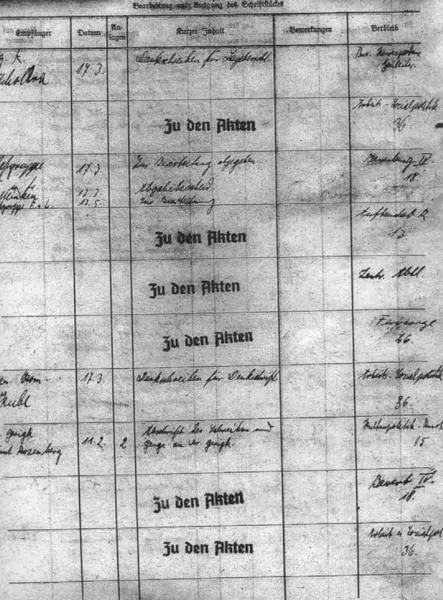
Part of the daily log from a German security unit in the Crimea, for March 17, 1942. Note the numerous notations for “ Juden Akten ” or Jewish Action, indicating liquidation operations against local civilians. The banality of evil is quite evident on this piece of bureaucratic memorabilia, with the most interesting touch being that the Germans actually used a stamp for ethnic-cleansing activities. (NARA)
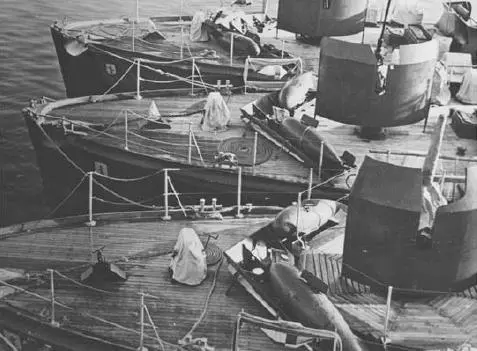
German R-Boats. The Kriegsmarine transferred the 3. Räumbootsflotille to the Black Sea in July 1942, and these small warships played a major role in the operations around the Crimea in 1943–44. Although intended primarily for coastal minesweeping, the R-Boats proved quite useful as convoy escorts, anti-submarine vessels, and even in surface combat against the Azov Flotilla’s motor gunboats. (Nik Cornish, WH 1180)
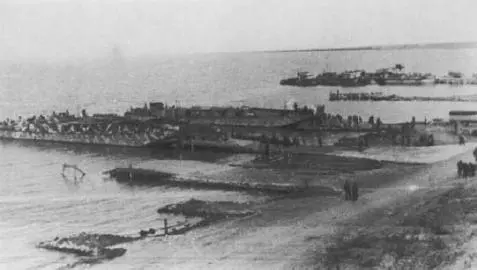
German high-speed landing barges (MFP) unloading troops on the Sea of Azov, 1943. As a bonus from the aborted Operation Sealion , the versatile MFP proved well-suited to the shallow waters off the Crimea. Soviet naval forces never had much luck in efforts to interdict MFP coastal traffic, and it was not until the Luftwaffe lost its bases in the Crimea that Soviet air power could inflict significant losses on these craft. (Author’s collection)
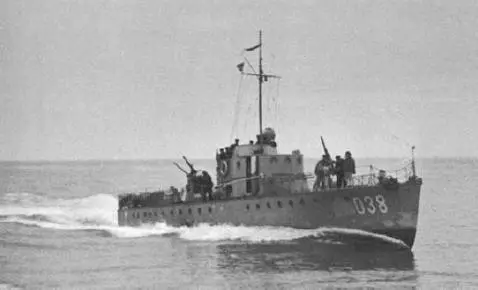
A Soviet MO-IV sub-chaser, SKA-038, operating off the Crimea. The Black Sea Fleet had 42 vessels of this type in service at the start of the war and built another 75 in 1941–44. This 50-ton, wooden-hulled vessel served as a jack-of-all trades in the Black Sea and was useful for landing troops and for escort duties. Although armed with two 45mm 21K guns, the MO-IV boats were much slower than the German Schnellboote , but about evenly matched with the R-Boats. (Author’s collection)
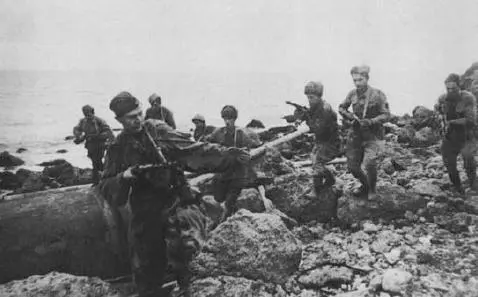
Scouts from the 2nd Guards Rifle Division “Tamanskaya” land near Yenikale on November 4, 1943. Small groups of scouts were landed on the rocky coastline by light vessels from the Azov Flotilla, but the Soviets lacked the amphibious craft to land tanks or heavy artillery across this type of terrain. The failure to secure the port of Kerch in the initial phase of the Kerch–Eltigen operation greatly delayed the Coastal Army’s breakout from their lodgment. (Author’s collection)

Troops of the 346th Rifle Division crossing the Sivash on November 1, 1943. Soldiers had to link arms during the crossing, lest they become mired in the soft bottom. It took over two hours to walk across this 1½-mile wide ford, but the Soviet crossing was initially unopposed and took the Germans completely by surprise. Note that all the infantrymen are armed with PPSH submachine guns, and the flat Crimean coast in the distance. (Author’s collection)

The Soviet 10th Rifle Corps had great difficulty in moving heavy weapons across the Sivash, and boats were nearly useless. Here, a 45mm anti-tank gun and two horses are being transported on two small boats, which must be pushed across the mud, rather than floated. It is interesting that German engineers thought that the Sivash could not be crossed by a large unit, and the ability of the Red Army to adapt and persevere in this kind of situation often dumfounded the more conventional German approach to warfare. (Author’s collection)

Tanks from the 19th Tank Corps race through Simferopol on April 13, 1944, after the breakout from the Sivash bridgehead. Vasilevsky’s decision to transfer this tank corps across the Sivash bridge rendered the German stand at Perekop futile and caused the entire Axis position in the Crimea to disintegrate virtually overnight. The 19th Tank Corps started the operation with 221 tanks and assault guns, including 63 British-built Valentine tanks. (Author’s collection)
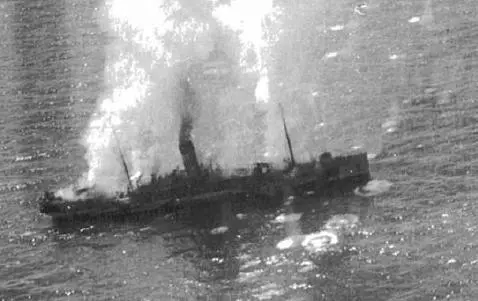
The freighter Totila under attack by Il-2 Sturmoviks on the morning of May 10, 1944, off Sevastopol. When it sank, it took an estimated 3,000 German and 1,000 Romanian troops with it. Soviet aircraft did not seriously interfere with the Axis evacuation from the Crimea until the final stages of the operation, but the concentration of Axis merchant shipping off the Chersonese was an easy target. (Author’s collection)
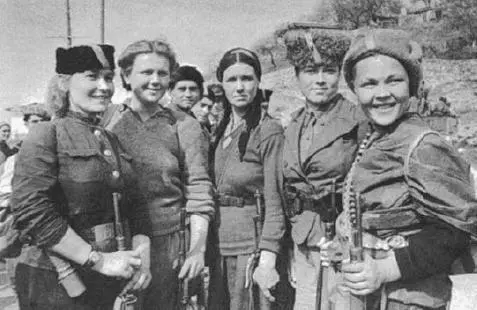
A group of smiling female partisans in the Crimea, May 1944. Soviet partisans participated in the liberation of some of the coastal cities, such as Yalta and Alushta, which were close to their operating areas, but they completely failed to interfere with the retreat of V Armeekorps through the Yaila Mountains. Had the partisans delayed this German retreat by even a few days, the Red Army would almost certainly have overrun Sevastopol before the Axis had a chance to evacuate the rest of AOK 17. (Author’s collection)

Soviet troops from the 2nd Guards Army in Sevastopol, May 10, 1944. The destroyed StuG-III assault gun in the foreground was probably blown up by the retreating Germans. Note that the building at left is the same one that the destroyer Svobodnyi was photographed next to in June 1942 . (Author’s collection)

German troops emerge from shattered buildings in Sevastopol to surrender on May 9–10, 1944. It is unclear exactly how many Axis troops were captured in the final days in the Crimea, but probably in the neighborhood of 8,000–10,000. (Author’s collection)
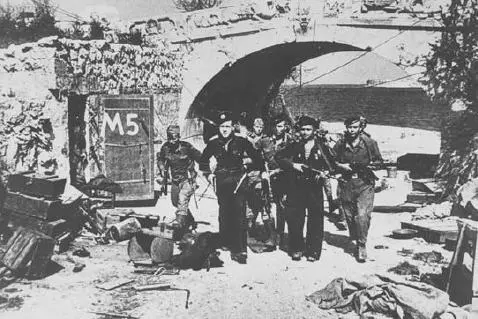
Soviet naval infantrymen entering Sevastopol near Nakhimov Square, May 10, 1944. Fort Constantine can be seen in the background. At the end, the Germans put up no real resistance inside Sevastopol but instead made a beeline for the evacuation beaches. (Nik Cornish, RA 190)
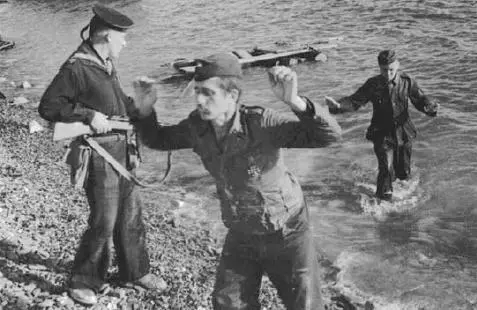
Two Germans who attempted to flee from the Chersonese on a raft are captured by a Soviet naval infantryman. A handful of Germans escaped on improvised rafts or floating debris, but most fell victim to strafing attacks by Soviet fighters. Hitler’s refusal to authorize an earlier evacuation condemned much of AOK 17’s troops to death or capture. (Author’s collection)

A Ukrainian BTR-70 armored personnel carrier occupies a defensive position near the Perekop Isthmus, March 2014. As in previous Crimean campaigns, control of the Perekop Isthmus is key terrain that both sides moved quickly to block.

Russian airborne troops arrived quickly in the Crimea in March 2014 in order to secure key facilities, but wore masks to conceal their identity. Nevertheless, their equipment – including RPG launchers – clearly identified them as regular troops and not the local patriots claimed by Russian television. Once the Crimea was annexed, Russian President Putin admitted that these men were, in fact, Russian troops.
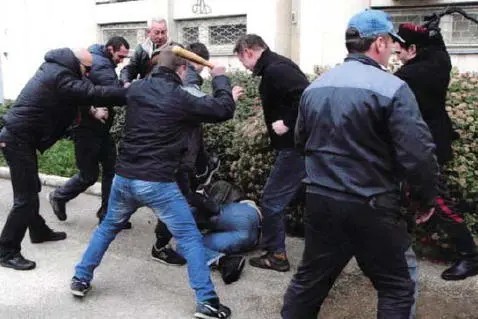
The face of Russian imperialism in the 21st century looks remarkably like it did in the previous three centuries. Russian agitators used violence to terrorize anyone in the Crimea who opposed their annexation plan. Note the Cossack wielding a whip – ample proof that very little has changed in the age-old game to dominate the Crimea.
Читать дальше




























































